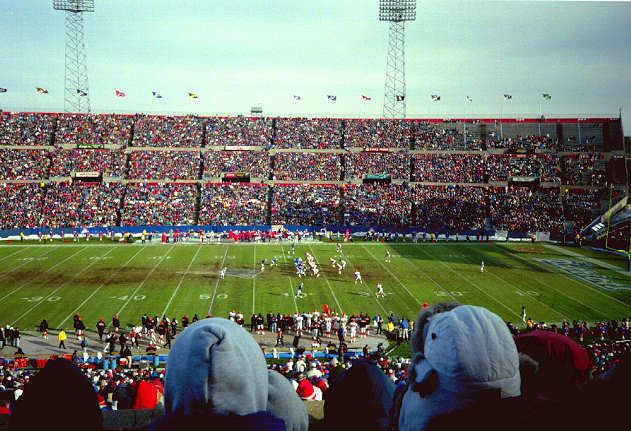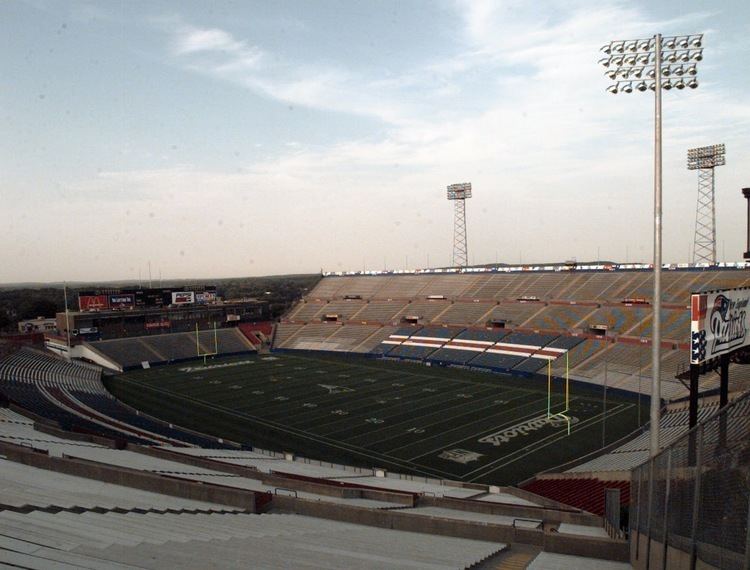Broke ground September 23, 1970 Capacity 60,292 | Closed January 19, 2002 Opened 15 August 1971 | |
 | ||
Similar Gillette Stadium, Nickerson Field, Giants Stadium, Silverdome, RCA Dome | ||
Foxboro Stadium, originally Schaefer Stadium and later Sullivan Stadium, was an outdoor stadium located in Foxborough, Massachusetts, United States. It opened in 1971 and served as the home of the New England Patriots of the National Football League (NFL) until 2001 and also as the home venue for the New England Revolution of Major League Soccer (MLS) from 1996 to 2001. The stadium was the site of several games in both the 1994 FIFA World Cup and the 1999 FIFA Women's World Cup. Foxboro Stadium was demolished in 2002 and replaced by Gillette Stadium and the Patriot Place shopping center.
Contents

History

The stadium opened in August 1971 as Schaefer Stadium, primarily as the home venue for the renamed New England Patriots of the National Football League. The team was known as the Boston Patriots for its first eleven seasons 1960–70, and had played in various stadiums in the Boston area. For six seasons, 1963–1968, the Patriots played in Fenway Park, home of baseball's Boston Red Sox. Like most baseball stadiums, Fenway was poorly suited as a football venue. Its seating capacity was inadequate—only about 40,000 for football—and many seats had obstructed views.
The Boston Patriots played the 1969 season at Alumni Stadium at Boston College in Chestnut Hill, and the 1970 season, their first in the NFL, at Harvard Stadium in Boston's Allston neighborhood.

The site was selected when the owners of Bay State Raceway donated the land, midway between Boston and Providence, Rhode Island. The general contractor who built the stadium was a Massachusetts-based company named J.F White Contracting Co.

Ground was broken in September 1970. It cost only $7.1 million (or $41.3 million in 2015 dollars)—only $200,000 over budget. Even allowing for this modest cost overrun, it was still a bargain price for a major sports stadium even by 1970s standards. This was because the Patriots received no funding from the Commonwealth of Massachusetts or the town of Foxborough; indeed, it was one of the few major-league stadiums of that era that was entirely privately funded.
Seating capacity
Playing surface
Like the majority of outdoor sports venues built in North America in the 1970s, Foxboro Stadium was designed for the use of an artificial turf playing surface. The original field was Poly-Turf, succeeded by AstroTurf. A natural grass field was installed before the start of the 1991 season.
Naming rights
The original name in 1971 was Schaefer Stadium for the brewery of that name in an early example of the sale of naming rights. When this agreement expired in 1983, Anheuser-Busch took over the rights. Instead of putting the name of one of its brands of beer on the stadium, Anheuser-Busch agreed to name it Sullivan Stadium in honor of the Sullivan family, majority owners of the Patriots. After the family sold their majority interest in the team to Victor Kiam, the stadium was officially renamed "Foxboro Stadium". Although the official spelling of the town's name is "Foxborough", the shorter spelling was used for the stadium.
Notable events
The venue hosted numerous significant soccer matches, including six games in the 1994 FIFA World Cup. Foxboro Stadium was the last stadium where Diego Maradona scored a World Cup goal, in a play against Greece, and where he last played in an official FIFA World Cup match against Nigeria on June 21, 1994.
The stadium hosted five games in the 1999 FIFA Women's World Cup, the 1996 and 1999 MLS Cups, and the inaugural Women's United Soccer Association Founders Cup.
The stadium was also the venue at times for the home football games of Boston College and hosted numerous other outdoor events, primarily concerts, along with music festivals, including The Monsters of Rock Festival Tour and The Vans Warped Tour, as well as the WWF King of the Ring tournament in 1985 and 1986.
Schaefer Stadium hosted Elton John on July 4, 1976, as well as Boz Scaggs, The Eagles, and Fleetwood Mac on July 25, 1976.
Sullivan Stadium hosted The Who's 25th anniversary tour on July 12 and 14, 1989.
Metallica and Guns N' Roses brought the Guns N' Roses/Metallica Stadium Tour to the stadium on September 11, 1992, with Faith No More as their opening act.
Madonna performed her "Who's That Girl" tour there on July 9, 1987, to a sell-out crowd. Bob Dylan and the Grateful Dead recorded a portion of their collaborative live album, entitled Dylan & the Dead, there on July 4, 1987. Pink Floyd played a two-night stand in May 1988 (on one of the nights their inflatable pig was torn to shreds). They also played a three-night sold-out stand in May 1994 on their The Division Bell Tour which was recorded and readily available on bootleg. (The second night was filmed by MTV for promotional purposes.) The Dave Matthews Band played seven shows at the stadium from 1998 to 2001.
The Rolling Stones played three nights on September 27 and 29 and October 1, 1989, and on September 4 and 5, 1994.
Additionally, in 1994, the Drum Corps International World Championships were held in the stadium.
Closing
By the late 1990s, Foxboro Stadium had become functionally obsolete by modern NFL standards. While it had very good sight lines, it had little else going for it. The facility was built cheaply as a "bare bones" stadium and had very few modern amenities. The stadium's plumbing was completely inadequate. After the toilets overflowed during its first game, stadium officials were forced to augment the permanent toilets with port-a-potties for the rest of the stadium's existence. It also lacked luxury boxes, an increasingly important source of revenue for other teams in the league. Most patrons had to sit on backless aluminum benches, as only a small fraction of the seats had chairbacks (painted blue, red and white near the 50-yard line). During heavy rains, the numerous unpaved spots in the parking lot turned to mud. It frequently took an hour or more to leave after games, as the stadium was built on the side of Route 1.
With a capacity of just over 60,000, it was one of the smallest stadiums in the NFL. It was also almost completely exposed to the elements, meaning that there was almost no protection for the fans late in the season. During particularly cold winters, the benches froze. Additionally, the Sullivan family had lost millions promoting the Jackson Victory Tour in 1984. Due to their relatively modest wealth compared to other NFL owners, they pledged the stadium as collateral for the tour. Knowing that the revenue from the Patriots would not be nearly enough to service the debt, the Sullivans quietly put the team and the stadium on the market. The Sullivans' financial picture didn't improve even when the Patriots made Super Bowl XX. With most of their money tied up in the team, they sold the Patriots to Victor Kiam in 1989. The stadium, however, lapsed into bankruptcy and was bought by paper magnate Robert Kraft.
When Kiam and Sullivan tried to sell the team to interests in Jacksonville, Kraft effectively stymied the deal by refusing to let the team out of an ironclad commitment to serve as the stadium's main tenant until 2001. As a result, when Kiam himself was crippled by financial troubles, he sold the Patriots to James Orthwein in 1992. After only two seasons, Orthwein tried to get out of the lease in order to clear the way for the Patriots to move to St. Louis, but Kraft refused to let the Patriots out of their lease. Orthwein then put the team on the market. However, due to the wording of the operating covenant, any prospective buyer would have had to negotiate with Kraft. With this in mind, Kraft swooped in and bought the team himself.
After 31 NFL seasons, Foxboro Stadium was scheduled to be demolished on December 23, 2001, the day after the Patriots' final home game. However, the Patriots made a run to get into the playoffs and went on to win their first Super Bowl. As a result, the stadium wasn't demolished until late January 2002, after the conclusion of the 2001 postseason. The last game played in the stadium, "The Tuck Rule Game", was played in a snow storm; a Patriots win against the Oakland Raiders, which famously featured an overturned fumble call based on the then applicable tuck rule in the final minutes. The stadium's former site became parking lots for its successor, Gillette Stadium, before being developed into the open-air shopping center Patriot Place.
